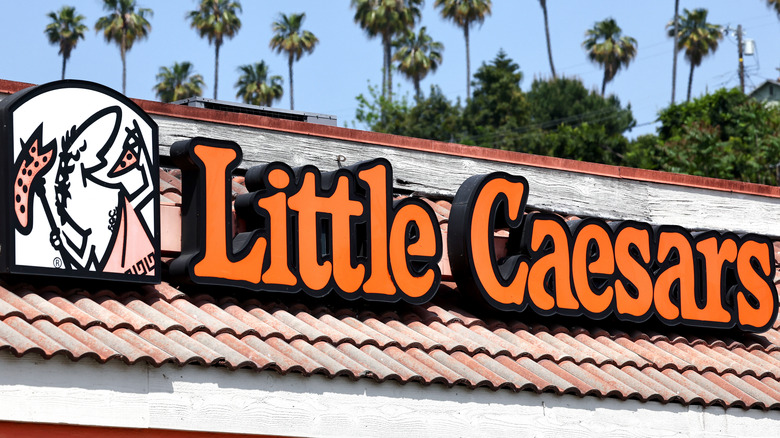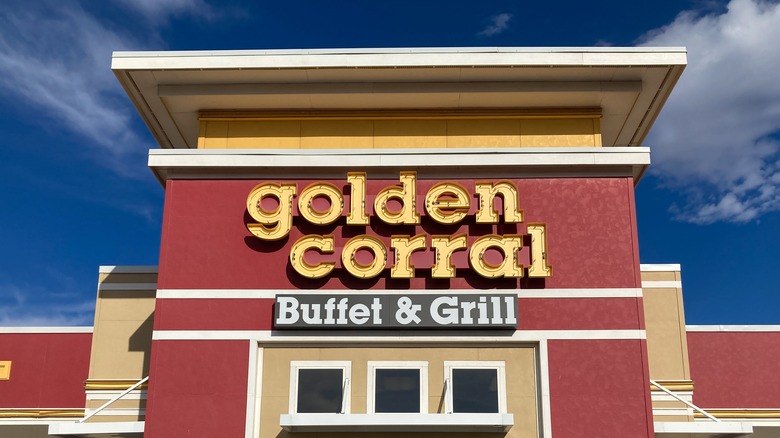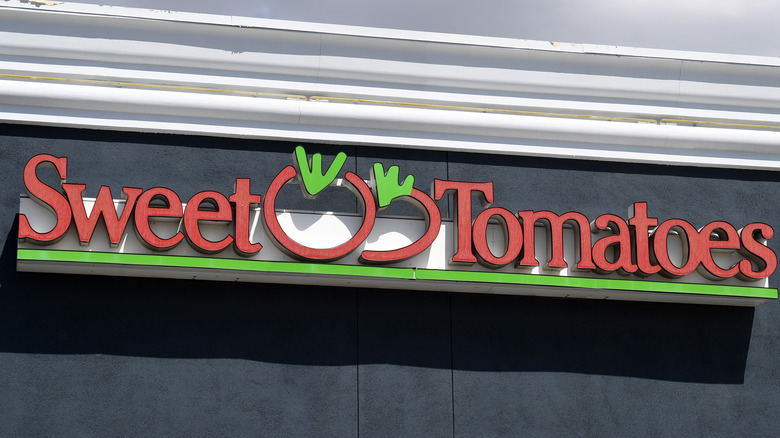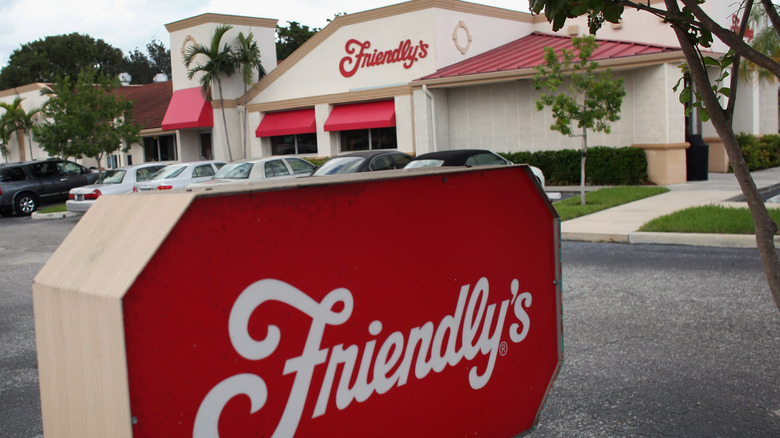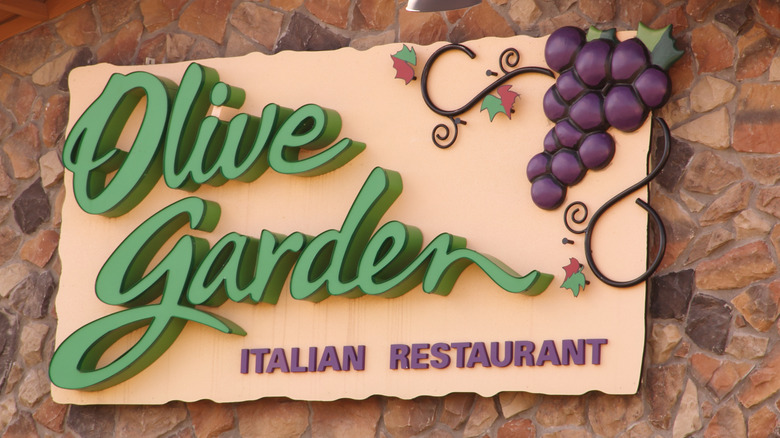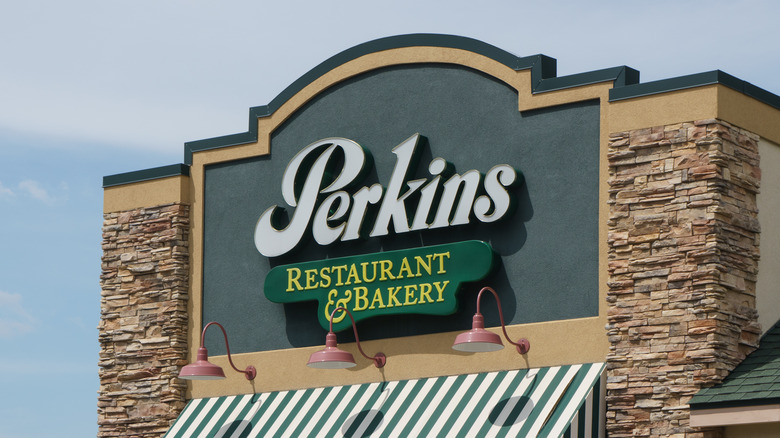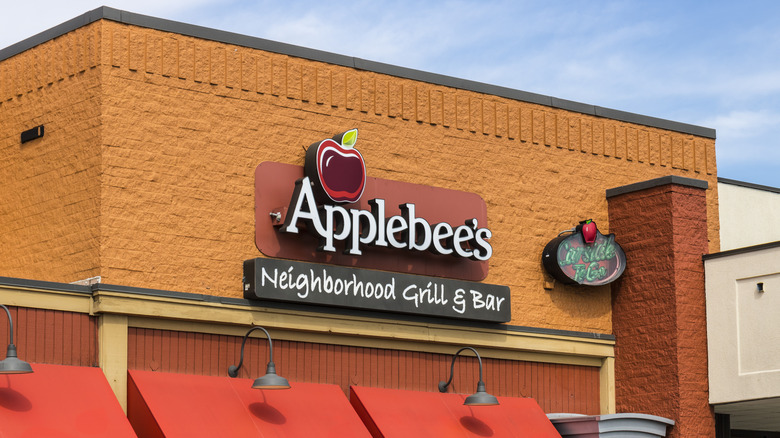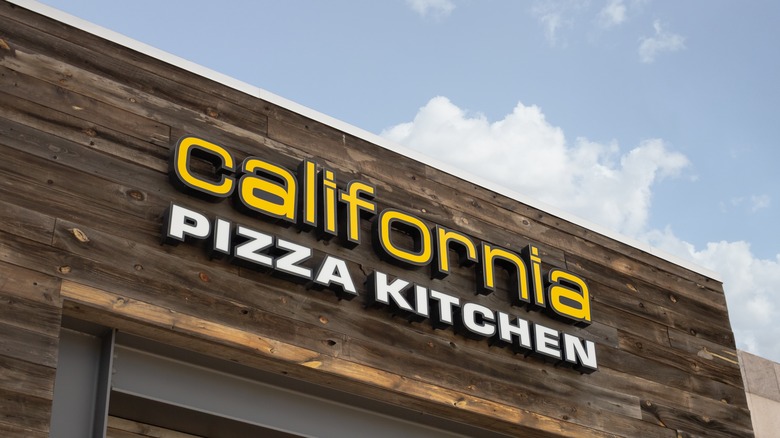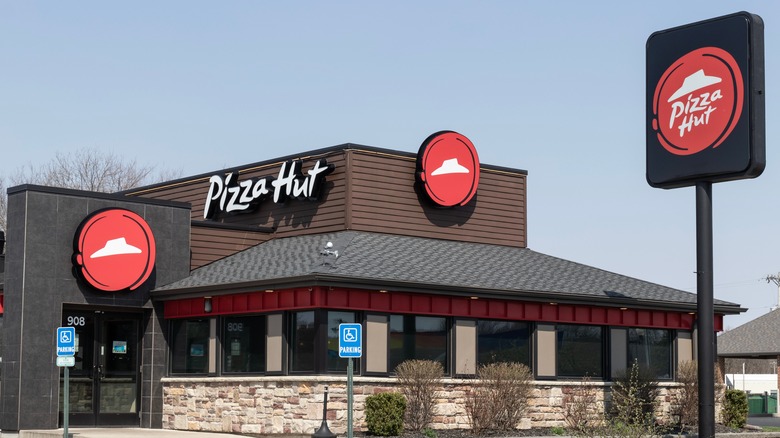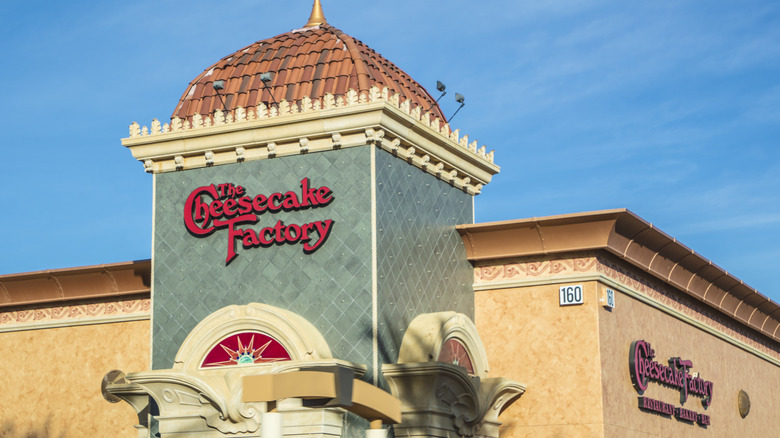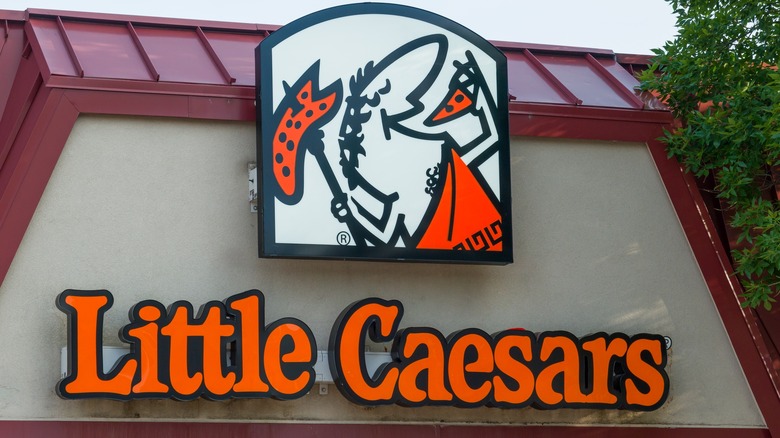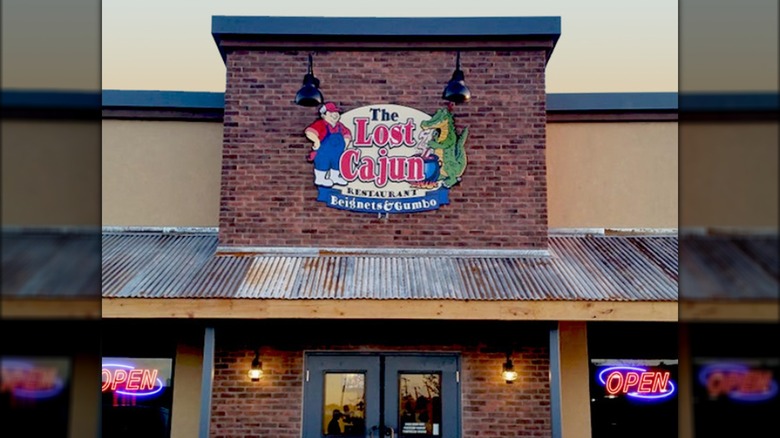11 Struggling Chain Restaurants That Completely Made A Comeback
Beginning in the early 2000s, we wondered if we were experiencing the slow and painful death of the chain restaurant. Restaurant goers were looking elsewhere for healthier options, and younger generations increasingly craved unique and trendy over reliable, cheap, or convenient. Even thousands of locations and global expansion couldn't guarantee success for struggling chain restaurants. Confronted with the ever-expanding market of curbside pick-up and food delivery apps, if a family-friendly chain didn't keep up with the times, it was all too easy to fall into bankruptcy, or worse, fade into irrelevance.
Other brands, however, knew how to keep their fingers on the pulse of the restaurant industry. Whether through the pruning of underperforming locations or an acquisition from a future-oriented parent company, many struggling chains have bounced back from hardships with grace, adapting to new times and learning how to provide customers with what they want most: a brand, an experience. While COVID-19 represented a bottleneck in the restaurant industry, and we still might lose some beloved chains because of it, plenty of brands squeezed through and are currently thriving. Read on to find out which struggling chain restaurants pulled off the most impressive comebacks.
1. Golden Corral
Golden Corral found itself in a downward spiral before 2020, plagued by unsanitary kitchen scandals, disgruntled employees, and the struggle to stay relevant in an oversaturated buffet market. COVID-19 was the final straw –– the last place Americans wanted to be was scooping mashed potatoes out of a communal tray in a crowded restaurant, cornering Golden Corral into bankruptcies, more than 100 restaurant closures, and 2,300 furloughed employees.
Rather than bow out, Golden Corral saw an opportunity to pull itself out of restaurant ruin, enhancing its sanitary policies and improving employee relations without increasing the cost for customers. After the pandemic's damage to the restaurant industry, Golden Corral had less competition, becoming a beacon for what Americans were craving most after hardship: familiarity, good times, and the best bang for your buck.
In 2022, the International Foodservice Manufacturers Association gave Golden Corral's CEO, Lance Trenary, the distinguished Gold Plate Award. By 2023, the chain was experiencing a 17% sales growth, with each location raking in an average of over $100,000 weekly. Leaning heavily into advertising to younger generations and its multicultural demographic, the restaurant chain has gone viral on social media and airs commercials on Telemundo in Spanish.
With even more room to grow, Golden Corral is branching out, opening the fast-casual Homeward Kitchen restaurant in North Carolina. Trenary told FSR Magazine, "We've caught lightning in a bottle at Golden Corral, and I want to make sure we figure out how to keep the lid on it."
2. Sweet Tomatoes
In 2020, Sweet Tomatoes announced the sad news that it would be shutting down all of its restaurants, hit hard by COVID-19 and an FDA crackdown on salad bars. Founded in San Diego as Souplantation in 1978, the all-you-can-eat chain once boasted 97 locations, building a sturdy base of restaurant goers looking for buffet-style quantities with farm-to-table quality. Devastated by the closures, Sweet Tomatoes' devotees kept the flames alive, thrilled to see the brand rise from the ashes in a 2023 announcement of the re-opening of one restaurant in Tucson, Arizona. CBRE, a real estate firm, revealed that it leased a former Sweet Tomatoes' building to new tenant ST Three LLC, a company that had recently secured the restaurant's intellectual property and a few previous operators.
The new owners drummed up the hype online, soft launching photos of the revamped buffet line in a post on X, formerly known as Twitter. The result was a flood of support with lines that wrapped around the building for the official re-opening on April 1, 2024. Fans returned the love with a massive social media boost, like one viral TikToker celebrating Sweet Tomatoes' revival as "the eighth wonder of the world."
Although it's uncertain whether the restaurant plans to expand outside Tucson, COO Mike Malone told AZCentral he had high hopes, saying, "It was a beloved brand. We knew from the social media outpouring that people want it back, that they would support it. So that's why we felt comfortable in thinking to the future."
3. Friendly's
Friendly's has experienced its fair share of ups and downs, and against the odds is still reinventing itself –– quite impressive considering it was founded as an ice cream shop in 1935 at the height of the Great Depression. Once an empire with 500 locations in the 1970s, the family-friendly chain fell on hard times in the 21st century, declaring bankruptcy twice within a decade. Most recently sold to Amici Partners in 2020, Friendly's is currently down to 103 restaurants, but CEO Sherif Mityas is determined the chain is in its comeback era. "Some of the restaurant's operations weren't to our brand standard," Mityas told Forbes referencing the pruning of 23 locations between 2020 and 2023, "They were old and tiresome. Sometimes to grow you have to shrink."
With a three-tiered revitalization plan in action, Friendly's is remodeling the interiors of its restaurants, adding new touches to the menu, and returning to its roots with marketing campaigns centered around the joys of family and ice cream. The chain has even partnered with the Jonas Brothers, offering Nick, Joe, and Kevin-themed sundaes on the menu. "We've been hooked on Friendly's since we were little," Kevin stated in a press release, "Fun fact: We decided on the band's name at our local Friendly's back in 2005."
The restaurant chain is also expanding beyond the Northeast and opening locations in Texas, a rapidly growing, economically-booming state that Mityas believes will only spur Friendly's upward trajectory.
4. Olive Garden
In 2014, things weren't looking so hot for Olive Garden. Younger dining cultures increasingly craved hipper options and more authenticity, while a damning 294-page report from the Starboard Value hedge fund published all the ways Olive Garden was running its restaurants wrong. The presentation critiqued the establishment's bloated menu and –– even worse –– failure to cook pasta correctly. Sparking a prompt management shakeup, the report turned out to be the springboard for Olive Garden's comeback.
Under new CEO Gene Lee, the chain went back to the basics, wiping the menu of non-Italian offerings, adding a higher-end wine selection, and expanding its takeout services — something that no doubt gave the restaurant a head start once the pandemic hit. Parent company Darden Restaurants enjoyed a 140% increase in stocks in the five years following the revamp efforts, while Olive Garden is still one of the highest-grossing chains in the U.S., with 2023 sales totalling over $5 billion.
Surprisingly, millennials have been driving business and lending the Italian-American giant a hand in its success. Restaurant university professor Christopher Muller pointed out to The Gazette, "Millennials haven't stopped buying homes and going to sit-down restaurants. They are just doing it a little later. Now these younger people are starting families, and that's always been Olive Garden's core audience." The Tuscan-inspired chain also keeps its dining rooms full thanks to steady menu prices despite inflation, while staying popular with promotions like the never-ending pasta bowl and lifetime pasta pass.
5. Perkins
Founded as Smithies Pancake House in 1957, Perkins Restaurant and Bakery encompassed almost 500 units across 32 states at its height in the late '90s. An ill-fated merger with Marie Callender's foretold a rocky 21st century for the chain, beginning with the unexpected closure of several locations in 2011. This resulted in bankruptcy and the loss of 65 restaurants and 2,500 jobs (via Reuters). In 2019, parent company Perkins and Marie Callender's Inc. filed for bankruptcy once again. Fortunately they were acquired by Ascent Hospitality Management, the company that would fuel Perkins' comeback.
In an effort to stand out amid inflation and fast food breakfast competitors, Ascent announced a complete makeover for Perkins' in 2024, including a remodel that chain President Toni Ronayne described to CBS as, "vintage fresh" with an "Americana vibe." The overhaul even includes a name change, omitting "Restaurant and Bakery" for Perkins American Food Co. While the iconic bakeries will still be prominent, the chain will offer new menu items like signature burgers with secret seasonings. It all kicked off with a new flagship spot in Orlando, which opened in March 2025. So far, things are going well.
Perkins' reimagined restaurants will be about half the size of the traditional locations, allowing the chain to invest in its new –– and even smaller –– fast-casual spinoff, Perkins Express, which could move into the small town and food court markets. Striving to keep the restaurants relevant, Ronayne told CBS, "Guests are really looking forward to an opportunity to enjoy American classics –– they want a piece of nostalgia. It's a slice of yesterday in a place that feels like today."
6. Applebee's
Everyone was "eatin' good in the neighborhood" when Applebee's opened its 1,000th location in 1998, having opened its first restaurant barely 20 years earlier. Kate Taylor, Business Insider's Retail Correspondant, details that Applebee's success was thanks to its reliability: "They weren't too fancy, they weren't too cheap, but they hit a nice sweet spot in the middle for people." Shortly after acquisition from parent company Dine Brands,Applebee's mojo was threatened by the 2008 recession. The chain attempted to stay afloat with a trendier vibe and upscale offerings like hand-cut steaks. Unable to save declining sales, however, the pivot flopped, prompting hundreds of restaurant closures.
New leadership from Dine Brands stepped up in 2017, introducing the chain's iconic Dollarita. The $1 margarita almost single handedly caused Applebee's comeback, attracting younger and older customers, driving food sales, and boosting alcohol to 15% of the restaurant's business by 2019.
With almost 1,600 stores across the country, Applebee's has remained one of the most recognizable brands in the U.S. (via Statista). While it may seem counterintuitive that Dine Brands is currently closing around 30 Applebee's locations, the goal is to cut costs and pump the successful restaurants with more resources. The parent company is also creating a new prototype by combining two brands, IHOP and Applebee's, into one location, with a possible smaller building footprint. Promotions like Applebee's Date Night help keep the chain strong, while a TikTok of Walker Hayes dancing to and singing "Fancy like Applebee's" definitely hasn't hurt, either.
7. California Pizza Kitchen
Being resourceful was nothing new for California Pizza Kitchen, a brand that started at one leased location in Beverly Hills on pooled funds from savings, bank loans, and friends. By 1992, less than 10 years after opening, CPK had 26 locations and an almost cult-like following. 2020 came on the heels of a rough decade for the restaurant, with stiff competition from fast casual restaurants and food delivery apps. Because dine in sales accounted for almost 80% of the pizza chain's business, COVID-19 wreaked havoc on CPK, dropping sales by over 75%, shutting down nearly 15% of its locations, and resulting in bankruptcy with a debt of $400 million (via FSR).
California Pizza Kitchen bounced back from the pandemic quickly, emerging from bankruptcy in November 2020 and increasing its U.S. sales by over $70 million in 2021. Apart from an enhanced marketing effort and some menu innovation, the real key to the restaurant's comeback was expansion: franchising locations both nationally and abroad and sliding into nontraditional markets like airports and stadiums. The brand is currently operating almost 200 locations in 11 countries, with no plans to stop expanding.
Jeff Warne, CEO since 2022, has initiated a multifaceted turnaround strategy that involves further investment into franchising, but also a renewed effort in appealing to loyal customers, rather than the more costly approach in attracting new clientele. These incentives have included rewards programs and a thank you sweepstakes, with winners' prizes ranging from $500 to $50,000.
8. Pizza Hut
It definitely looked like a bad omen when Pizza Hut closed its longest continuously operating restaurant in 2015. Founded in 1958, the red roof pizza chain had grown to 11,000 locations in almost 100 countries, but the closure came in the midst of a rough decade and declining sales, largely due to the struggle for dine-in locations to keep up with delivery orders. Culminating in bankruptcy and the closure of 300 U.S. restaurants in 2020, franchisee Flynn Restaurant Group acquired ⅕ of the pizza behemoth's locations in 2021 to revive the struggling brand.
By 2023, same-store sales in the U.S. had increased by 8% –– the biggest leap in 13 years –– and system sales had grown roughly 5% in 15 years. Flynn achieved Pizza Hut's slow-burning comeback by slashing underperforming locations and shifting focus to where the real money is in the world of pizza: delivery. Chris Turner, CFO for parent company Yum Brands, stated in an interview that partnering with third-party delivery services has been a success, "If the restaurant is running short of drivers we can use aggregators as a relief valve to get delivery capacity."
Pizza Hut is also bringing back favorites like the Big New Yorker pizza, and introducing new items like the hand-held Melts sandwiches meant to attract solo diners. The brand reaches its younger crowd by fueling engagement on social media, like this TikTok with almost two million views of Lil Jon's "Pizza wHut" remix that had "no reason to go this hard."
9. The Cheesecake Factory
When Evelyn Overton opened a small cheesecake bakery in Detroit, she probably didn't envision her son borrowing inspiration and later founding The Cheesecake Factory in southern California. By 2013, the chain boasted 163 locations in the U.S., expanding internationally into the Middle East, East Asia, and Mexico. Its upward trajectory hit some struggles in the 2010s, however, when restaurant goers were increasingly demanding healthier options. Men's Health dubbed The Cheesecake Factory "America's absolute worst family restaurant," for its excessive portions and calorie counts. While sales declined in 2017, the chain's desperation hit rock bottom in 2020, when CEO David Overton publicized a letter to landlords expressing the restaurants' inability to pay rent due to the coronavirus crisis. 27 restaurants closed and stocks plummeted.
Fortunately, The Cheesecake Factory had planted the seeds for its comeback in 2017 when it turned to tech to attract customers. All of its locations went live online to offer delivery services, and social media campaigns pushed the image of the chain's fresh, high-quality ingredients. While the pandemic no doubt haltered the turnaround, The Cheesecake Factory has remained one of America's most popular sit-down restaurants, with 340 restaurants globally under all its brands. Currently back in a growth phase, Overton explained to Nation's Restaurant News,"We're planning to open as many as 22 new restaurants in 2024, including as many as three to four Cheesecake Factories, six to seven North Italia's, six to seven Flower Childs and six FRC restaurants."
10. Little Caesars
When Mike and Marian Ilitch opened the first location in a suburb of Detroit in 1959, nothing could prepare them for all of Little Caesars' ups and downs. Throughout the '70s, the rapidly expanding pizza chain specialized in takeout, offered competitive deals, and established its iconic slogan, "Pizza! Pizza!" By 1993, it boasted 4,500 locations in all 50 states, with $2.3 billion in sales. For context, just a decade earlier the chain's sales were at $1 billion, and in 1990 it had 2,700 locations.
With mounting competition from other pizza chains, Little Caesars experienced an identity crisis in the mid-90s. In an odd move to combat declining sales, the chain invested less in advertising, phasing out its classic slogan, and taking on a more serious tone in its commercials, which just didn't stick. Over 400 stores unexpectedly closed in 1999, while the brand was also battling a lawsuit with disgruntled franchisees.
Little Caesars took the first step to its comeback in 2001 by settling the class action lawsuit and drastically improving conditions for its restaurant owners. The chain returned to what it knew best, introducing an enticing $5 Hot-N-Ready promotion and re-establishing its "Pizza! Pizza!" advertising. By 2011, the pizza chain had 3,500 locations, up from 1,343 nine years earlier. Already an expert at takeout, Little Caesars was one of the few restaurants to thrive during the pandemic and as of 2024, the brand is easily one of the largest pizza chains in the world.
11. The Lost Cajun
The Lost Cajun's sudden success turned out to be a double-edged sword. Founded as a pipe dream by Raymond Griffin and his wife in Frisco, Colorado, the restaurant struck immediate success, with lines wrapping around the building for its opening in 2010. Its family-friendly atmosphere was a hit for tourists and locals alike, not to mention its bayou-inspired fare was considered quite "exotic" for rural Colorado. By 2015, the restaurant was franchising, and as Griffin explained to FSR, "Look, anybody that wanted it, and they could show me excitement, I was saying, 'yeah, let's go.' And then I paid for it."
With 26 locations in seven states by 2019, the chain started to lose its footing and had to close a few units, but then the pandemic hit, forcing the brand to declare bankruptcy and claim roughly $1.5 million in liabilities. The Lost Cajun had to shed six restaurants, reduce employee salaries, and mitigate or completely forgive struggling operators' franchise fees.
To stage its turnaround, restaurants expanded on deliveries, boosting takeout to 35% of total sales by 2022. For context, it was only 10% pre-COVID. The chain emerged from bankruptcy in late 2021, and shortly after, Griffin road tripped to all locations to meet with and talk over the last few years with franchisees.
Currently planning to regrow, The Lost Cajun was acquired by the franchise consulting group Executive Decisions Group Inc., who see promise in the chain and are excited to continue expanding it (via Restaurant Business).
